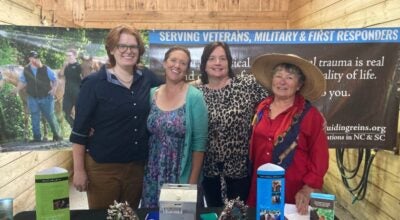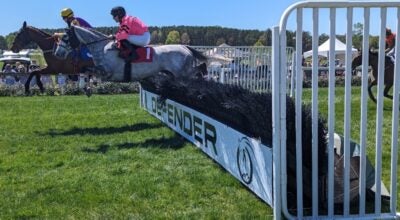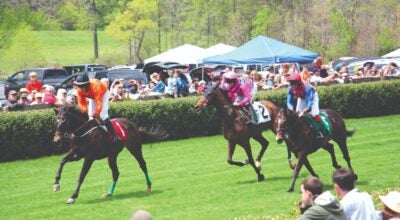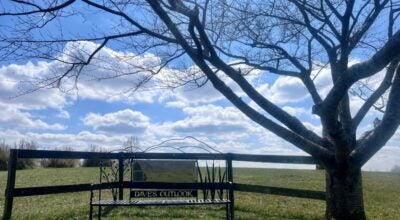Learning from dressage’s best
Published 4:32 pm Thursday, June 25, 2015
By Judy Heinrich
Life in Our Foothills, February 2015
Since their arrival at the sports highest levels, the dressage world has been awestruck by the pairing of the UK’s Charlotte Dujardin and the 12-year-old Dutch Warmblood gelding, Valegro.
At their championship debut, Dujardin and Valegro won team gold at the 2011 European Championships, and then won the FEI World Cup Grand Prix in 2011, and team and individual gold at the London Olympics in 2012. They are current World Champions and hold all three dressage World Records: Grand Prix, Grand Prix Special and Grand Prix Freestyle.
They have routinely shattered scoring records, most recently setting new world records for Grand Prix and Freestyle at the December 2014 London International Horse Show at Olympia. Their 94.3000 Freestyle score earned 25 perfect 10s from the judges.
Their story is even more of a fairy tale: After childhood success in show jumping and Pony Club, Dujardin took up dressage as a teenager and studied for four years with Judy Harvey, a renowned international Grand Prix rider and coach, FEI 4* judge, and a selector for the British Olympic Dressage Team.
In 2007, at age 22, Dujardin took some lessons at the farm of elite British dressage rider, trainer and instructor Carl Hester. He offered her a chance to work with him for ten days and then, with Harvey’s encouragement, invited her to stay on indefinitely.
One of her early responsibilities there was to bring on the five-year-old novice Valegro, who was intended as a future ride for Hester. But after witnessing the development of their unique partnership, Hester let Dujardin keep the ride. Hester and Dujardin have since been gold-medal-winning teammates at the European Championships and London Olympic Games, and Dujardin remains at Hester’s yard today.
In 2014, Tryon dressage rider Cathy Berlin was lucky enough to attend Dujardin’s first-ever U.S. clinic, a symposium co-presented with her former trainer Judy Harvey. When I asked Berlin to share some thoughts about the experience, she suggested an alternative. One of the friends she had attended the symposium with, Diane Skvarla, had been a working student for Judy Harvey years ago while earning her British Horse Society certifications. Skvarla wrote a summary about the symposium for the Potomac Valley Dressage Association Newsletter, an article that went on to win a first place award from the U.S. Dressage Federation.
So, with thanks to Cathy for suggesting it and author Diane Skvarla for giving us permission, here are some excerpts from that article, originally titled “Training Doesn’t Happen Overnight.”
About the symposium
This was an opportunity not to be missed; to learn more from Judy and to hear from her famous former working student, Charlotte. The two-day clinic proved highly instructive and entertaining. Judy and Charlotte gave the audience invaluable training advice and kept everyone laughing with their witty commentary. They worked well together, with Charlotte teaching the riders and Judy observing and commenting from a trainer’s and judge’s point of view.
Charlotte’s routine and riding
It was interesting to hear that Carl and Charlotte work their horses only four days a week, with two days “hacking” or trail riding, and one day of rest. On work days, upper level horses hack for 20 minutes, then stretch for 15 minutes in the ring, train for 40 minutes, and finish by stretching and walking. All their horses go in the fields: “Carl lets horses be horses.”
Charlotte works her young four- and five-year-old horses for only 20 minutes, “keeping everything really easy and clear,” and she never does sitting trot with them until they are about six. “For me it is more important that I get his back strong enough and that I feel that the horse remains forward.”
She gives a lot of verbal praise and takes frequent walk breaks, but never picks up the contact at the walk. “I always walk with them on a long rein; you don’t want to interrupt the walk at all when they are a young horse.”
The audience was treated each day to a demonstration of Charlotte’s training techniques and precise riding style (on participants’ horses). Once Charlotte started to put (a) horse through his paces the transformation was astonishing. A very ordinary trot became world class and the canter was similarly spectacular.
At one point Charlotte described what she was doing to get the cadence in the trot: “My reins are slowing and my legs are saying go, but I’m not blocking him. All I’m doing is creating more suspension and more lift.”
How does Charlotte ride the way she does? “I think it’s something I’ve definitely worked at… I think the way I sit now is just through my core ability of being strong and having strength in my seat not to be able to just hold on to my reins… I try and have the feeling when I sit on the horse that I sit in the saddle and my legs aren’t gripping around the horse – my legs just hang. So when I want to use my leg, I can use my legs, when I don’t want to use my legs the horse isn’t becoming numb to my legs. I think that’s one of the hardest things to be able to do is not to grip.”
After watching her for two days, it is clear that it isn’t only natural talent that she possesses. Charlotte is determined, competitive, focused, disciplined, and unwavering (even dogged) in seeking perfection. She works out religiously to stay in shape, knowing that aerobic exercise and a solid core allow her to ride to her best ability; she has learned to focus her mind to eliminate distractions when competing; she watches other top riders to help her improve; and she never allows herself to be sloppy in her riding.
Symposium training and exercises
Horses at the symposium ranged in ability from Training Level to Grand Prix, with several amateur riders participating with the professionals. All the horses visibly improved during their sessions, but it was hard work for the riders, with Charlotte and Judy keeping them on their toes.
Charlotte emphasized that this was training and not to worry about mistakes. But poor riding, such as bad transitions and corners, was unacceptable and Charlotte did not mince words when that occurred, retorting: “That was terrible, do it again,” and, “If you do bad transitions at home you will do bad transitions in the arena.”
She was quick to note that it was never the horse’s fault, telling the audience: “Pat the horse, slap the rider.” The mood was kept light with plenty of positive reinforcement.
It was clear that many problems stemmed from the horse not honestly being in front of the leg. In those moments, Charlotte yelled, “Yeehaw!” – by which she meant to gallop immediately. She added, “If a horse is in front of your leg you can pretty much do anything.”
Charlotte took the whip away from most riders, noting that she only uses the whip when she wants to make the horse “bounce.” She emphasized that the whip is “not there to make my horse go.” Rather, the horse must react immediately from the leg, and never a nagging leg.
She added: “Lazy horses need your legs off; hot horses need your legs on.” She sympathized that it is difficult to take your legs off a lazy horse, but that you have to be disciplined as a rider and not keep kicking.
Charlotte noted that most riders think of the walk as a breather, but it is a movement that should be practiced daily, especially as it has a co-efficient of two in most tests. As well as practicing the walk, Judy emphasized the importance of the halt, as it is the first impression you give the judge. “There is no excuse for not practicing it and getting it really, really correct right at the beginning of the horse’s training; it has to be correct for the level.”
Throughout the weekend Charlotte time and again reminded riders to shorten their reins, as long reins tended to create a backward hand. Judy commented that Charlotte’s hands are always thinking forward. Charlotte gave out her secret to success, telling several riders, “Short reins win gold medals.”
Riders were challenged to improve and praised when progress was made. For the spectators it was a tutorial in dressage training, with constant emphasis on the basics and a recognition on the need to be precise and in control at all times.
“Training doesn’t happen overnight,” Charlotte pointed out. “It’s not something you fix in a few days or weeks. It’s only through the training and the discipline that you’ll make it better.” Judy agreed: “It’s a discipline. It’s something you have to work at.”
Diane Skvarla’s entire award-winning “Training Doesn’t Happen Overnight” article can be read at www.pvda.org under Newsletter/Archive, May 2014.






